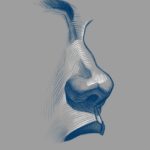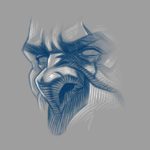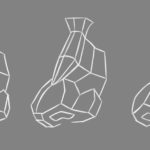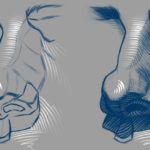Hi and welcome back to the second video in this lesson series on how to draw perspective.
Just in case you missed the previous lesson, be sure to click the link below to watch it now:
Perspective Lesson 1 – Introduction To Perspective Drawing
So in today’s lesson, we are going to break down all the basic component of a perspective drawing so you can have a really comprehensive view of the whole picture and really know how everything fits together.
So here are all the elements of a perspective drawing that you need to know about:
(Note: Below are a brief summary of the definitions of all the perspective elements. For a more detail explanation, please refer to the video above.)
The Observer
Every perspective drawing or picture is seen from the point of view of the observer. The observer is like the main character and we are essentially see the scene through his/her eyes.
The Cone of Vision
The cone of vision is defined as the scope of what the observer can see clearly when looking into a scene.
The cone of vision is important because it determines what is going to be in our perspective drawing.
The Eye Level / Horizon Line
The eye level is quite simply the height of the observer’s eyes from the ground. If the observer’s eyes are 6 feet off the ground, then the eye level will be at 6 feet.
The eye level is also one and the same as the horizon line in a perspective drawing.
Some artist like the define the horizon line as the line where the sky meets the ground. This is a true and useful definition for outdoor landscape drawings where that line is clearly visible.
But it is not a useful definition for scenes indoor where the sky and the ground are covered up.
Therefore, it is much better to remember that the horizon line is always the same as the eye level of the observer.
The Picture Plane
The picture plane can be though of as your drawing paper itself. It takes in all the 3D images in the scene and transform it into a 2D drawing.
Vanishing Points
Vanishing points are created because of the fact that as things move further away from our eyes, they appear smaller.
Therefore, in a perspective drawing, as things recede away from the observer, they get smaller and smaller until they appear to disappear (or vanish) into a vanishing point.
Vanishing points are a huge component of perspective drawing because they help artist to determine how to draw all the straight lines in the drawing.
We will talk more about vanishing points in future lessons.
So that’s basically all the elements of a perspective drawing. I hope that wasn’t to confusion.
In tomorrow’s video, we are going to dive into the different types of perspective and I’ll explain just how one point perspective works.
Now if you are already subscribed to my free drawing newsletter, all you have to do is watch your inbox for an email from me tomorrow.
But if you have not signed up yet, you can do that for free by entering your email into the form below…
So that’s it for today’s perspective lesson.
If you like this lesson, please hit the “LIKE” button on this page and also share it with all your friends using the social sharing buttons on this page.
Please leave a comment below to let me know what you think.
Thank you for visiting and I’ll see you tomorrow!

![Linear Perspective Drawing Lesson Series [1 of 6] – Introduction To Drawing Perspective In Art](https://mydrawingtutorials.com/wp-content/themes/Extra/images/post-format-thumb-text.svg)
![Linear Perspective Drawing Lesson Series [4 of 6] – How To Draw One Point Perspective](https://mydrawingtutorials.com/wp-content/uploads/2013/08/One-Point-Perspective-Drawing-Exercise.jpg)
![Linear Perspective Drawing Lesson Series [5 of 6] – Drawing a Room In Perspective Tutorial](https://mydrawingtutorials.com/wp-content/uploads/2013/07/drawing-a-room-in-perspective.jpg)






Very exact, precise video. Links very good. Like very much.
Good video. Thanks
Hi Ethan
I’ve long been fascinated by perspective. I’ve purchased many books on the subject and done many exercises and I must admit that you’ve -excuse the expression- dumbed it down for me. You’ve made what could seem to be a complicated subject much simpler. The mark of a good teacher. Keep up the good work.
Rick
Your lessons are awesome! Thanks for all the effort that you have put into these lessons.
Thanks a lot Ethan, first day I saw a 3d drawing I was amazed.
It has been months now trying to make mine.
Thanks a lot for sharing, though i only draw structures like walls houses and cubes also i’m lazy addin details.
it has helped me on my coursework thanks
if an oserver watches a sea from the top of a moutain what will be the horizon line ?
Thank you for the question. The horizon line will be at the eye level of the observer. If you are standing on a mountain and your eyes are 1000 feet up from the ground, the horizon line will be 1000 feet up from the ground.
Even if you are looking down towards the ocean (instead of looking straight ahead) the horizon line will still be at the same please (since your eyes are still at the same height).
Good lesson. I’ll be referring to it often.
This is the clearest explanation for what perspective is. Thanks Ethan.
Very informative. I am really understanding your information and will be able to apply them in my drawings. Thank you!
Hi thank you for the info great video. i have a question.. when you take about the vanishing point in min 1:48 where is the person located?? am a bit confused is he on the opposite side of the vanishing point?. and does center of vision mean?.. thanks
I bought the CD’s for portrait drawing and perspective made simple.
I was follwing along for the drawing of the house and I not able to
find the drawings to print and follow the projest could you help me
acess the drawings. I am very interested in this project.
Thank you,
Calvin
I think your classes are great, even though this is only the second one I’ve seen. This one was excellent.
Thank you very much, Judy!
Thank you so much for tuition that explains everything so well and also very easy to understand. You never fail to impress. Thanks again. Mary.
Great presentation! Thanks, Marlene
Hi Ethan
i am so glad that you are doing perspective – luv what i have seen so far – please keep sending the lessons – lots to learn